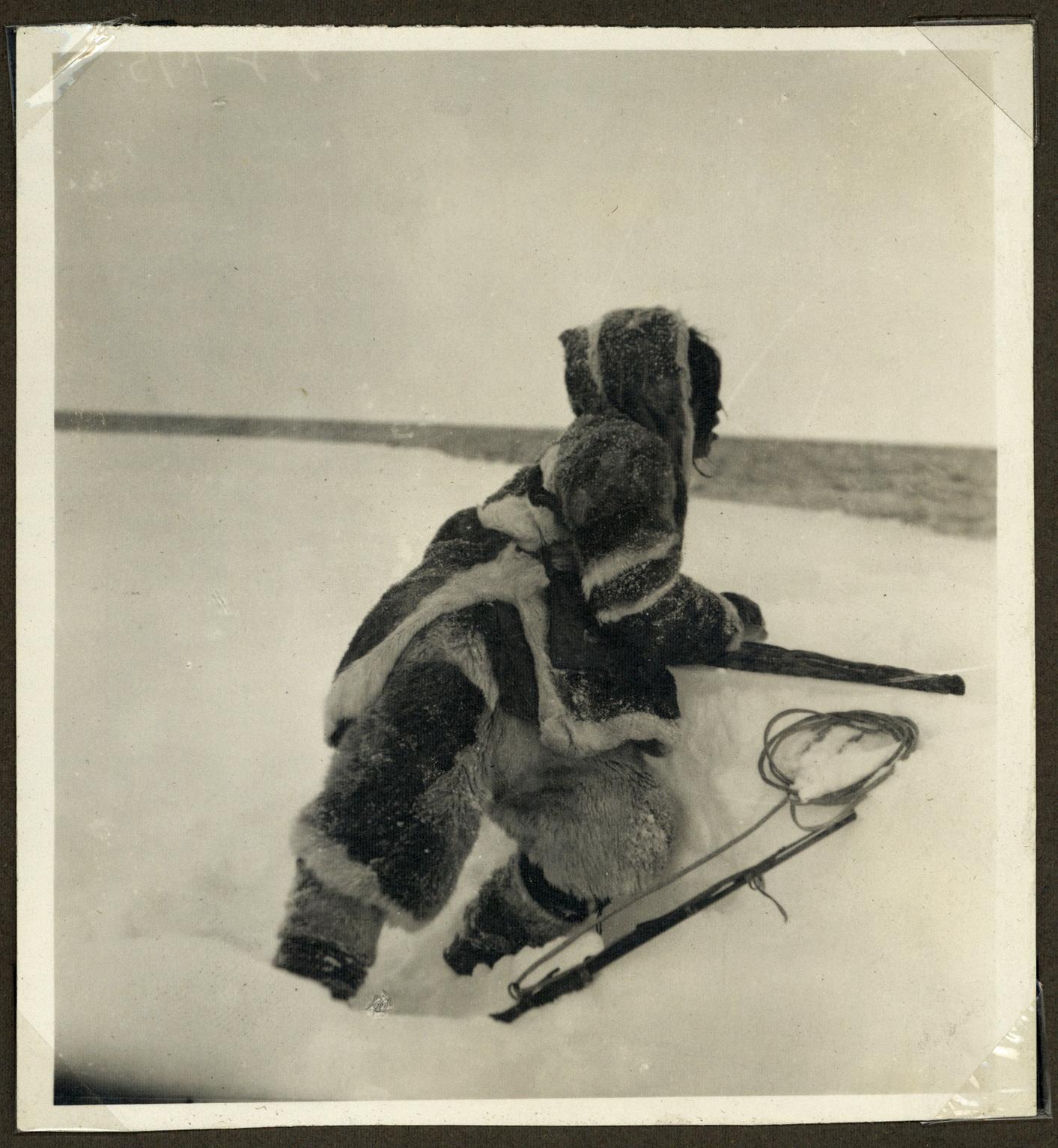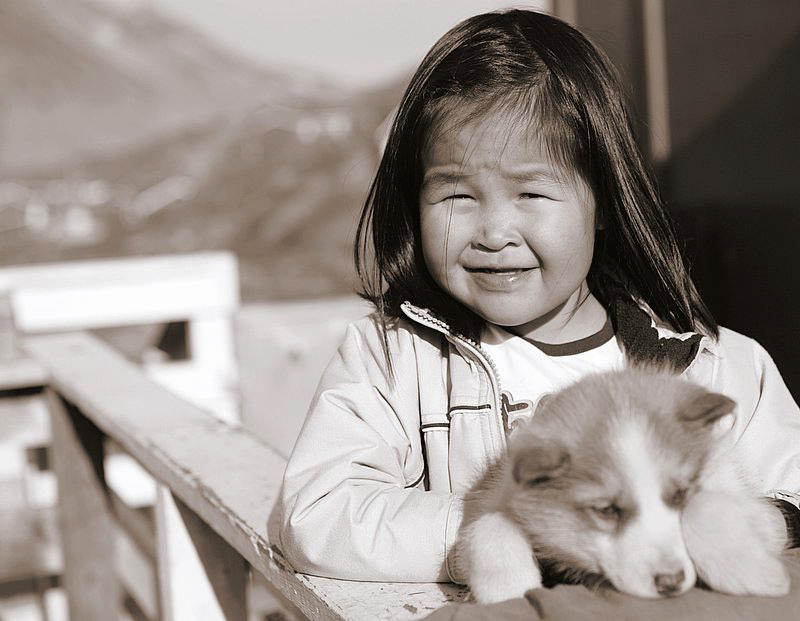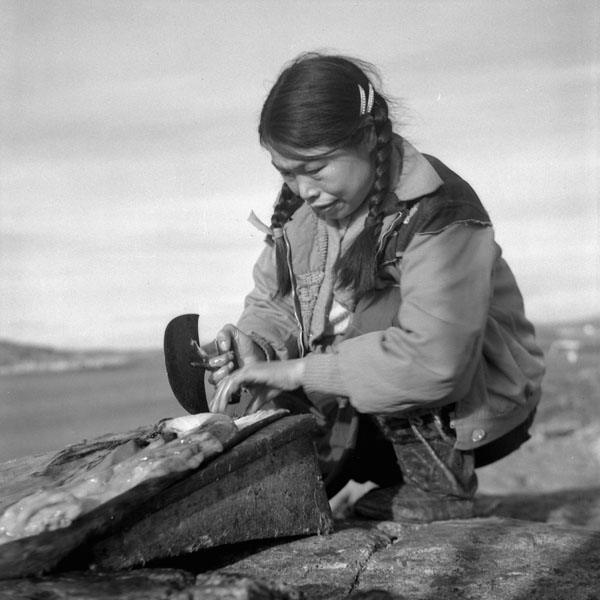Executive Summary
Many studies have been carried out on indigenous Inuit groups in Alaska, Canada and Greenland, elucidating the human exposure to contaminants, such as POPs and heavy metals. In general, the levels of POPs and heavy metals in Arctic populations have decreased over the years, which might be related to their change in diet by consuming less traditional foods. A connection between the concentrations determined and the location was found; the higher concentrations were found in the more remote areas where the Inuit still rely more on the traditional foods. Efforts to communicate this risk have been made in populations of all three Arctic regions, but obviously there are challenges in comprehensively informing all affected people.
Title picture source: Rosemary Gilliat/National Film Board of Canada (august 1960), Taktu Cleaning Fat from Seal Skin with an Ulu.
1. Introduction
In Inuit groups of Alaska, Canada and Greenland the human exposure to persistent organic pollutants (POPs) and heavy metals appears to be generally higher than in other countries. This can be caused by the consumption of traditional foods, as a connection between the consumption of traditional marine food resources and the human exposure to these contaminants have been determined (ADLARD et al. 2018, DONALDSON et al. 2010, BONEFELD-JORGENSEN 2004). The Inuit culture is based on living in and of the nature in the Arctic, and their survival was primarily based on professions as fishermen or hunters. Where hunting and fishing are still a big part of the Inuit culture, which is especially common in the more remote areas, there are still high consumption rates of traditional foods.
To determine the contaminants in the Inuit populations of Alaska, Canada and Greenland and to see if the levels are related to age, amounts and types of consumed traditional foods, location, gender and pregnancy, several adult and mother-child cohort studies have been carried out in different projects (ODLAND & NIEBOER 2012, MUCKLE et al. 2001, BJERREGAARD et al. 2001). The data and results from the projects in the Alaskan Arctic (AN MOM), the Canadian Arctic (IHS, NCDS, NHSQ) and Greenland (INUENDO, CLEAR, IVAAQ, ACCEPT, IHT) are all collected in the reports of Arctic Monitoring and Assessment Programme (AMAP) - Human Health in the Arctic (ADLARD et al. 2018, DONALDSON et al. 2010, ODLAND & NIEBOER 2012, WEIHE et al. 2016, DONALDSON et al. 2016, SUNDSETH et al. 2015, DUDLEY et al. 2015).
2. Diet and the Effects of Traditional Food
The Inuit in the three regions considered here are, as already mentioned, consuming high amounts of traditional foods which is an important part of their cultural and social context. The traditional foods consists of fish, marine mammals (including whales and seals), terrestrial animals (including caribou, muskox, and polar bears) and birds. The type of animals hunted depends on the area and traditions.
These traditional foods, especially the marine mammals, contains high levels of POPs and metals. Even though the consumption of fish and caribou based food is higher than marine mammal foods in large parts of the regions, the pollutant levels in the marine mammals are much higher. Therefore marine mammals and fish are today considered the primary source for POP exposure to indigenous people (AMAP 2015). Considerable hazardous effects of POPs have been identified in sea birds, birds of prey and marine mammals.

Iglulik-inuit. License: Creative Commons CC BY-SA 2.0.
Consumption of high amounts of traditional foods, containing high levels of POPs, leads to high exposure to POPs and heavy metals, which were associated with a variety of health effects including neurotoxic effects, immunodeficiency, endocrine disruption effects, and cancer development (DONALDSON et al. 2010, SONNE et al. 2017, KVIST et al. 2014, DONALDSON et al. 2013, BONEFELD-JORGENSEN et al. 2011, LETCHER et al. 2010, AMAP 2015).
The consumption of the traditional foods are, due to the cohorts, found to be increased with age along with the contaminant levels. This might be caused by changes in the Inuit communities, such as adopting a more urbanized lifestyle, and the accessibility of commercial food, which makes the younger population consume less traditional foods.
3. Persistent Organic Pollutants (POPs) Exposure
The persist organic pollutants are chemicals, that are found to be persistent in the environment and to have long half-lives in air and biota. These chemicals are typically lipophilic, which means they bind to fatty tissues, which is why they are found to bioaccumulate in whales and seals. POPs contain a lot of different chemicals but some of the important groups are polychlorinated biphenyls (PCBs), polybrominated diphenyl ethers (PBDEs), organochlorines (OCs) and poly- and perfluoroalkyl substances (PFASs) (AMAP 2015).
3.1 Alaska
A biomonitoring study was carried out for the Yup’ik mothers as a part of the Alaskan Native Maternal Organics Monitoring (AN MOM) program from 1999-2012, where the POP compounds investigated were oxychlordane, trans-Nonachlor, p,p’-DDT, p,p’-DDE, HCB, b-HCH, Mirex, PCBs, PBDEs, PBB153, PFOS, PFOA, PFNA, PFDA and PFHxS. The study was based on samples from maternal blood and umbilical blood from some of the infants from the mothers sampled from 2009-2012. In general, the study showed a decrease of POP levels in the maternal samples from the sampling period 2009-2012.
Some of the contaminant concentrations deviated from the general tendency. All the PCB levels except for PCB153, showed a consistent decrease from 1999-2012. The PCB153 was found the predominant PCB congener in the period 2004-2006. However, PCB 153 levels were decreasing significantly in the period 2009-2012. For PBDE congener investigated, lower sum concentrations were found for PBDE47, PBDE99, PBDE100 and PBDE209 in the period 2009-2012 compared to 2004-2006, except for PBDE153 that was found to be higher in 2009-2012 than in 2004-2006. However, no clear trends were found in this survey, which may be associated with environmental changes, changes in community accessibility and the intake of traditional food among young women, which have not been distributed equally in the Yukon-Kuskokwim Delta population. Those populations living along the coast do not have the same access to terrestrial mammals (i.e. muskox, moose and caribou) as people living in-land. Therefore, these communities rely more heavily on the marine mammals as a food resource, which elevates POP content.
The majority of the PCBs and OCs levels in infant blood samples were found in similar concentrations as in maternal blood. All the PBDEs and PFASs are, however, were found in lower levels in infants compared to the corresponding mothers. For some of the contaminants quantified, more than 70% of the samples were below the limit of detection (AMAP 2015).
3.2 Canada
The data from the surveys contains concentrations of POPs among women in child bearing age (WCBA) and for adult men and women in general in the populations of the Inuit regions Nunavik, Nunavut, Nunatsiavut and the Inuvialuit Settlement Region. For the WBCA study, the surveys showed highest concentrations of POPs in Nunavik and lowest in Nunatsiavut. PBDE concentrations seems to be relatively equal in all four Inuit regions investigated. The women investigated in the WCBA seem to have lower concentrations compared with the general population study, which may be explained by the cohort composition. The WCBA study focused on young women, whereas the comparative study represented women across all age stages.
In general, men seem to usually have higher POP concentrations than women of all ages, including the WCBA. However, no clear difference between genders was determined in Nunavik. The difference of gender in the target regions, except for Nunavik, appears to be caused by differences of intake in traditional food, as men consumes higher amounts of traditional food. Also the survey showed, that older adults consume higher amounts of traditional food than younger adults.
Geographically there is also a difference in the concentrations of POPs, which is due to different the lifestyle and dietary habits of the Inuit in Canada. Since higher concentrations are found in marine mammals than in fish and caribous, higher levels of POPs are found in the Inuit population in the eastern Canadian Arctic (Nunavut and Nunavik), as they depend more on the marine mammals.
Among pregnant women in Nunavik, a biomonitoring study has shown that there is an overall decline of POP levels by an average of 80% over the 20 years study. The trend has also been observed in other parts of the Canadian Arctic (AMAP 2015).
3.3 Greenland
Compared to other Arctic regions, Greenland indigenous populations have in the past had the highest reported POP levels, and the population is still exposed to high levels of POPs.
During the project the Inuit Health in Transition (IHT), three PCBs (PCB138, PCB153 and PCB180) were especially found in high concentrations in both genders and across all age groups, and also for pregnant women (reported by the ACCEPT project). Along with other PCBs found in high concentrations, these seems to increase significantly with increased age, which supports the known age-related bioaccumulation of organochlorine compounds. For younger men and women, the concentrations were found to be lower than in older people (also confirmed by the INUENDO study). The levels of POPs in men were found almost twice as high as in the women, except for HCB, which was approximately the same in both genders. This might be due to women’s lower intake of traditional food, loss of contaminates during pregnancy and breastfeeding children, or a dietary guidance that has successfully reached the WCBA Inuit in Greenland.

License: Creative Commons CC BY 2.0.
The INUENDO study reported that the age and seafood intake are related to exposure of OCs and PFOS in the Greenlandic population. This was not confirmed for PBDEs, where the geographical location was an important determinant for exposure instead. A similar exposure profile was found for PFOS. Highest concentrations for PFOS were found in the southern and eastern regions in Greenland, which were compared to the mid- and southwestern region.
In general, differences in the human exposure of POPs appears to be related to the geographic place of the Inuit residence, as a higher intake of traditional food are found in the more remote areas. Due to the Inuit Health in Transition study, the highest levels of the OCs were found in the villages of the five areas. All the areas compared, the highest concentrations were found Avanersuaq (northern Greenland) and in villages in East Greenland, and the lowest found in Nuuk. The same pattern was found for the PCBs, that are found highest in villages, and lowest levels in Nuuk. For pregnant women, the ACCEPT project also observed the highest levels of OCs and PCBs in East and North Greenland. The levels of PBDEs for pregnant women, though, did not seem to relate to the geographical location as reported in the INUENDO (AMAP 2015).
4. Heavy Metals Exposure
High levels of heavy metals have been found in marine mammals, especially mercury (Hg), cadmium (Cd) and lead (Pb) (BECKER, 2000). With the projects carried out in connection with the AMAP, these three heavy metals and selenium (Se) were examined in the Inuit population of Alaska, Canada and Greenland (ADLARD et al. 2018, SUNDSETH et al. 2015, OBRIST et al. 2018, LEMIRE et al. 2015, AMAP 2015).
4.1 Alaska
Samples of the Yup’ik maternal blood in 2009-2012 have, according to the AN MOM study, showed decreased levels of metals as cadmium (Cd), mercury (Hg) and lead (Pb) since 2004-2006.
For both mercury (Hg) and lead (Pb), the samples showed a steady increase of levels between the periods 1993-2003 and 2004-2006. However a rapid decrease was found for recent periods. In 2009-2012 the levels for Hg and Pb are less than half the levels found in 2004-2006. Cadmium (Cd) appears to decrease steadily throughout the entire sampling period. Selenium was measured for the first time in Yup’ik mothers in 2009-2012, and showed similar results to the amounts found in the general US population.
The variation in Pb and Hg observed in the AN MOM study may be caused by the unequally distributed exposure profiles, community accessibility and due to lower traditional food consumption by the young part of population. It might also be due to the change in hunting by using modern technological support (i.e. long reaching rifles, boat engines and snowmobiles) (AMAP 2015).
4.2 Canada
As for the POPs, also the levels of metals are generally decreasing among the Inuit groups in Canada.
In Nunavik a temporal data collection has been conducted on pregnant women in the Ungava Bay and Hudson Bay area, which showed a decrease in levels of metals from 1992-2013. Lead (Pb) and mercury (Hg) are found in 2013 at half the levels determined in 1992. Selenium (Se) have also decreased in the period but not as consistent as lead. However, Hg increased slightly during the period 2007-2013. Change in food habits are assumed to be the major reason in the here observed trends.
Among children, a decrease for all metals was determined, which is also attributed to the change of diet. The NCDS project studied the metals in children at the age 5 and then again at the age 11, where they found a decrease in the levels of all metals in11 year old children. Here also Selenium (Se) was approximately half the levels in 5 year old children. The reason for this, could as mentioned, be a change in the diet in-line with a decrease in the consumption of traditional food from the age of 5 to the age of 11 years.
Men were found to have generally higher concentrations of Pb and Hg compared to women in all four Inuit regions. Although in Nunavik, the Hg levels in women were found a bit higher than then men’s, even though they consume bigger amounts of traditional food. Selenium was similar between the genders. Compared to all the women, the WCBA have lower concentrations of metals, which can be caused by that the group containing “all women” have a higher mean age. The concentrations of metals among the WCBA are found highest in the Nunavik region and lowest in the Nunatsiavut region, that are similar to Inuvialuit Settlement Region.
4.3 Greenland
The concentrations of metals in the Inuit groups of Greenland are mainly related to the geographic location. The highest concentrations of mercury (Hg) and selenium (Se) were found in the North-west, Avanersuaq and especially in the villages, compared to the East, South-west and Nuuk. The levels were in general higher in the villages, compared to the larger towns, and in East Greenland, the levels in the villages were found to be up to five times higher than the levels found in the town, Tasiilaq.
The INUENDO study confirmed, as already shown in the Canadian Arctic, that levels of metals were almost doubled in men compared to women. However cadmium (Cd) was found in similar concentrations in both genders.
In pregnant women from Disko Bay investigated in the ACCEPT survey, Hg and Pb were found in lower levels compared to previous studies. The same study in Nuuk, showed lower levels of Pb compared to earlier investigations, but here the Hg seems to be in the same range as earlier reported. This means that the levels of mercury in pregnant women in Nuuk seems to have stabilized, where they are still decreasing in the Disko Bay area. In general, the pregnant Inuit women in North Greenland are found to have much higher levels of Hg than women from other regions in Greenland.
Compared to Danish pregnant women, the concentrations of metals as Pb, Hg, Cd and Mn in Greenlandic women were similar. The levels of Se, though, were higher in Greenlandic populations (AMAP 2015).
5. Risk Communication
Risk communication in the Arctic has various challenges, especially the conveying language and gaining audience trust for information delivery. Risk communication have been carried out in all Arctic regions, including specific Inuit populations of Alaska, Canada and Greenland based on results produced under the auspice of AMAP (AMAP 2015). Different models and theories about risk communication have been carried out throughout the years. Along with the challenge of communication in a specific location, these models can be fundamental for developing risks communication strategies in the Arctic. For instance, one model is the “Seven Cardinal Rules of Risk Communication” by Covello and Allen (COVELLO & ALLEN 1988). According to their model when communicating risks, the message has to be clear, the communication should be a respective two-way communication and the messenger needs to be trustworthy.
5.1 Communication Experiences
In Nunavik, Canada, there has been a ban on lead (Pb) shot since 1999, due to the high amount of blood Pb, and an associated awareness campaign. Regulators communicated via radio, articles in periodicals, brochures and posters in different languages, municipal officials and merchants. Despite the comprehensive communication approach, according to a follow up survey only 31% of the hunters in Inukjuak were aware of the ban. Due to the Nunavik Child Development Study, more comprehensive risk communication was carried out focusing more on individual groups than the general public. The risk communication contained study participants, including, among others, employees of regional health and social services, regional organizations and health officials from other northern regions of Canada. Also in Nunavut a public risk communication campaign was carried out for the Inuit Health Survey, where a bit more than half of the surveyed people had heard the public messages and a third of the surveyed people had changed their diet because of the risk communication.
A very simple risk communication campaign was carried out in Greenland focusing on obesity, not the contaminants in traditional food. The communication included guidelines giving information for a “healthier” lifestyle, recommending the consumption of local and traditional marine foods. A survey of the campaign found that 43% did hear about the campaign, primarily through television and brochures, but the survey does not determine if these 43% are following the recommendations. (AMAP 2015)
As with the risk communication in Inuit populations of Canada and Greenland, there are challenges with reaching all the people in the populations and how to make the campaign surveys more exact. As most of the Inuit populations have access to internet, social media could be used to reach more people. The receivers can also share the health messages with others, and in that way reach even more people. This method may also prevent communication problems that might occur, such as building trust and the risk of creating only one-way communication. (AMAP 2015)
5.2 The Arctic Dilemma
Considering risks associated with traditional food consumption, a very important aspect, besides the strategies, is “The Arctic Dilemma”.
The surveys of the human exposure to contaminants from traditional foods in the Arctic, showed a decrease of the contaminants levels in the indigenous populations in Alaska, Canada and Greenland, in connection with the less intake of traditional foods. What is not considered in the surveys measuring the contaminants is the beneficial effects of traditional foods compared to the exposure of contaminants, which is called “The Arctic Dilemma” by AMAP 2009.
Traditional foods provides different nutritional benefits, such as vitamin A, iron, calcium, magnesium and omega-3 fatty acids, which do not seem to be covered well enough by the imported foods. The imported foods do provide some nutrients but most of the food contains a high amount of sugar or a low density of nutrients. When changing the diet from a lifestyle based on hunting and eating traditional foods to consuming more imported food, weight gain and obesity seem to increase in prevalence. The traditional foods are also beneficial economically and a big part of the cultural and social life among the indigenous populations in the Arctic. (AMAP 2009) Therefore, the beneficial aspect of the traditional food is important to take into consideration when giving Inuit recommendations on the diets and in the communication of the risks.
Concentration of Chlorinated Hydrocarbons and Heavy Metals in Alaska Arctic Marine Mammals
Persistent organic pollutants (POPs): state of the science
AMAP Assessment 2009: Human Health in the Arctic
This assessment report details the results of the 2009 AMAP assessment of Human Health in the Arctic. It builds upon the previous AMAP human health assessments that were presented in 19981 and 2022.
The Arctic Monitoring and Assessment Programme (AMAP) is a group working under the Arctic Council.
AMAP Assessment 2015: Human Health in the Arctic
The 2015 Human Health Assessment Report follows three previous AMAP assessments on human health (AMAP 1998, 2003, 2009) and represents the current knowledge base after 25 years of focused study. This report includes new knowledge, updates and fills information gaps identified in past reports, and focuses attention on the most recent integrated scientific knowledge related to environmental contaminants and human health. It does not update information concerning the levels and effects of radioactivity and UV-radiation; these topics were addressed in the first comprehensive AMAP Assessment Report (AMAP 1998). The AMAP 2015 collects and discuss all the data from the relevant cohorts and surveys carried out in Inuits groups of Alaska, Canada and Greenland. It describes the projects, the results as the levels of contaminants found in the areas, the health that these contaminants can cause, future risks, and risk communication.
Exposure of Inuit in Greenland to organochlorines through the marine diet
The Human Health Effect Programme in Greenland
Seven Cardinal Rules of Risk Communication
Environmental contaminants and human health in the Canadian Arctic
Climate Change in the North American Arctic: A One Health Perspective
Exposure to persistent organic pollutants and sperm sex chromosome ratio in men from the Faroe Islands
Exposure and effects assessment of persistent organohalogen contaminants in Arctic wildlife and fish
Prenatal exposure of the northern Quebec Inuit infants to environmental contaminants
Human biomonitoring in the Arctic. Special challenges in a sparsely populated area
AMAP Assessment 2015: Human Health in the Arctic
The 2015 Human Health Assessment Report follows three previous AMAP assessments on human health (AMAP 1998, 2003, 2009) and represents the current knowledge base after 25 years of focused study. This report includes new knowledge, updates and fills information gaps identified in past reports, and focuses attention on the most recent integrated scientific knowledge related to environmental contaminants and human health. It does not update information concerning the levels and effects of radioactivity and UV-radiation; these topics were addressed in the first comprehensive AMAP Assessment Report (AMAP 1998). The AMAP 2015 collects and discuss all the data from the relevant cohorts and surveys carried out in Inuits groups of Alaska, Canada and Greenland. It describes the projects, the results as the levels of contaminants found in the areas, the health that these contaminants can cause, future risks, and risk communication.
Inuit Dietary Patterns in Modern Greenland
The article approaches two different types on dietary patterns in Greenland. The two dietary patterns are analyzed in relation to urbanization and socio-economic positions in the use of interview, where FFQ is used a survey instrument. The survey also shows a relation between the location and amount of traditional food, but also the relation between healthy lifestyle and gender.
BJERREGAARD, P. ; JEPPESEN, C. (2009): Inuit Dietary Patterns in Modern Greenland. In: International Journal of Circumpolar Health: Volume 69 Issue 1, 13-24. URL [Accessed: 09.01.2019] PDF

